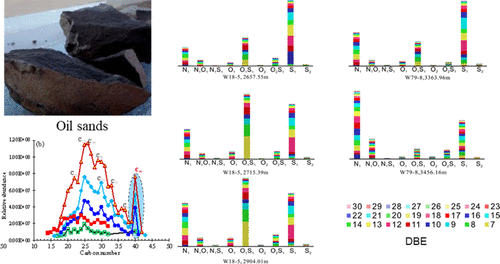Our official English website, www.x-mol.net, welcomes your feedback! (Note: you will need to create a separate account there.)
Molecular Characterization of NSO Compounds and Paleoenvironment Implication for Saline Lacustrine Oil Sands by Positive-Ion Mass Spectrometry Coupled with Fourier-Transform Ion Cyclotron Resonance Mass Spectrometry
ACS Omega ( IF 4.1 ) Pub Date : 2021-09-24 , DOI: 10.1021/acsomega.1c03801 Hong Ji 1, 2, 3 , Sumei Li 3 , Hongan Zhang 4 , Xiongqi Pang 3 , Yongshui Zhou 4 , Long Xiang 4
ACS Omega ( IF 4.1 ) Pub Date : 2021-09-24 , DOI: 10.1021/acsomega.1c03801 Hong Ji 1, 2, 3 , Sumei Li 3 , Hongan Zhang 4 , Xiongqi Pang 3 , Yongshui Zhou 4 , Long Xiang 4
Affiliation

|
NSO compounds mainly exist in geological bodies in the form of nonhydrocarbons and asphaltenes with abundant geological and geochemical information. Combined with the gas chromatography mass spectrometry (GC–MS) technology, positive-ion electrospray ionization Fourier-transform ion cyclotron resonance MS (FT-ICR MS) was used to understand the composition and distribution characteristics of NSO compounds in the oil sands of the Dongpu Depression and to explore their paleoenvironmental significance. The results show that n-alkanes are characterized by an even carbon number and phytane dominance, suggesting a saline lacustrine environment. Certain abundance of nC37 and β-carotane, high gammacerane content, and low diasterane content are detected in the analyzed samples, reflecting the saline-reducing paleoenvironment for the organic matter. Nine types of heteroatom compounds are detected: N1, N1O1, N1S1, O1, O1S1, O2, O2S1, S1, and S2. The main compounds are S1 and N1 compounds, followed by O1S1 compounds. The double-bond equivalent (DBE) value of S1 compounds is mainly distributed between 3 and 12, and the carbon number is mainly distributed between 18 and 35. The DBE value of N1 compounds is mainly distributed between 4 and 14, and the carbon number is mainly distributed in the range 15–35. Among the S1 compounds, DBE3 compounds (thiophenes) have relatively more sulfur-containing carotenoids (C40). The abundance of C40 S1 and the ratio of pyridine and its homologue DBE4–8/DBE9–12 N1 compounds show a good contrast with the paleoenvironment indicators of gammacerane/C30 hopane and diasterane/regular sterane. They can be used as a reference for the paleoenvironment index. Maturity is another factor affecting the distribution of NSO heteroatoms in the oil sands. NSO compounds are enriched in the DBE area with higher condensation, and the main peak carbon shifts forward. As the maturity increases, the relative abundance of N1 compounds increases, the aromatization intensifies, and carbon is broken into short chains. The research results shed light on the potential application of NSO compounds in petroleum exploration based on FT-ICR MS.
中文翻译:

正离子质谱联用傅立叶变换离子回旋共振质谱对盐渍湖相油砂的 NSO 化合物的分子表征和古环境意义
NSO化合物主要以非烃类和沥青质形式存在于地质体中,具有丰富的地质地球化学信息。结合气相色谱质谱 (GC-MS) 技术,采用正离子电喷雾电离傅立叶变换离子回旋共振质谱 (FT-ICR MS),了解油砂中 NSO 化合物的组成和分布特征。东浦凹陷及其古环境意义的探讨. 结果表明,正构烷烃具有偶数碳数和植烷优势,这表明盐湖环境。一定丰度的n C 37在分析的样品中检测到β-胡萝卜素、高伽马蜡素含量和低二甾烷含量,反映了有机质的减盐古环境。检测到九种杂原子化合物:N 1、N 1 O 1、N 1 S 1、O 1、O 1 S 1、O 2、O 2 S 1、S 1和S 2。主要化合物是S 1和N 1化合物,其次是O 1 S 1化合物。S 的双键当量 (DBE) 值1化合物主要分布在3~12之间,碳数主要分布在18~35之间。N 1化合物的DBE值主要分布在4~14之间,碳数主要分布在15~35之间. 在S 1化合物中,DBE 3化合物(噻吩)的含硫类胡萝卜素(C 40)相对较多。C 40 S 1的丰度和吡啶及其同系物DBE 4-8 /DBE 9-12 N 1化合物的比例与伽玛蜡烷/C 30的古环境指标显示出良好的对比藿烷和二甾烷/常规甾烷。它们可以作为古环境指数的参考。成熟度是影响油砂中 NSO 杂原子分布的另一个因素。NSO 化合物在 DBE 区域富集,冷凝度较高,主峰碳向前移动。随着成熟度的增加,N 1化合物的相对丰度增加,芳构化加剧,碳被分解成短链。研究结果揭示了 NSO 化合物在基于 FT-ICR MS 的石油勘探中的潜在应用。
更新日期:2021-10-06
中文翻译:

正离子质谱联用傅立叶变换离子回旋共振质谱对盐渍湖相油砂的 NSO 化合物的分子表征和古环境意义
NSO化合物主要以非烃类和沥青质形式存在于地质体中,具有丰富的地质地球化学信息。结合气相色谱质谱 (GC-MS) 技术,采用正离子电喷雾电离傅立叶变换离子回旋共振质谱 (FT-ICR MS),了解油砂中 NSO 化合物的组成和分布特征。东浦凹陷及其古环境意义的探讨. 结果表明,正构烷烃具有偶数碳数和植烷优势,这表明盐湖环境。一定丰度的n C 37在分析的样品中检测到β-胡萝卜素、高伽马蜡素含量和低二甾烷含量,反映了有机质的减盐古环境。检测到九种杂原子化合物:N 1、N 1 O 1、N 1 S 1、O 1、O 1 S 1、O 2、O 2 S 1、S 1和S 2。主要化合物是S 1和N 1化合物,其次是O 1 S 1化合物。S 的双键当量 (DBE) 值1化合物主要分布在3~12之间,碳数主要分布在18~35之间。N 1化合物的DBE值主要分布在4~14之间,碳数主要分布在15~35之间. 在S 1化合物中,DBE 3化合物(噻吩)的含硫类胡萝卜素(C 40)相对较多。C 40 S 1的丰度和吡啶及其同系物DBE 4-8 /DBE 9-12 N 1化合物的比例与伽玛蜡烷/C 30的古环境指标显示出良好的对比藿烷和二甾烷/常规甾烷。它们可以作为古环境指数的参考。成熟度是影响油砂中 NSO 杂原子分布的另一个因素。NSO 化合物在 DBE 区域富集,冷凝度较高,主峰碳向前移动。随着成熟度的增加,N 1化合物的相对丰度增加,芳构化加剧,碳被分解成短链。研究结果揭示了 NSO 化合物在基于 FT-ICR MS 的石油勘探中的潜在应用。



























 京公网安备 11010802027423号
京公网安备 11010802027423号